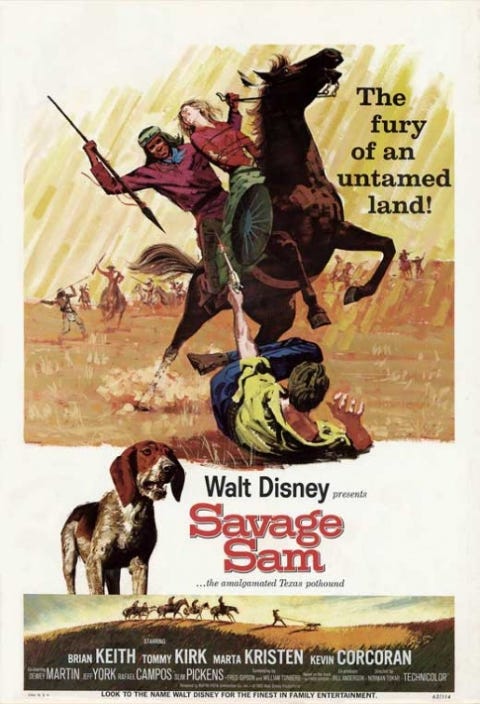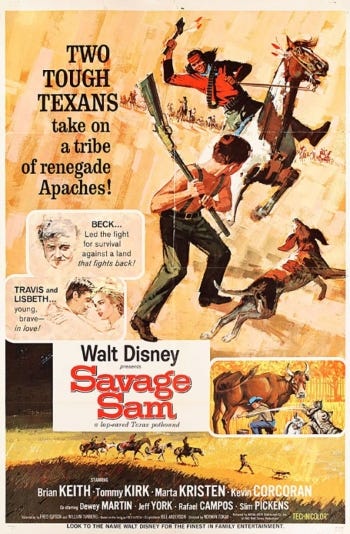Disney Plus-Or-Minus: Savage Sam
For years, Walt Disney had been an outspoken opponent to the very idea of sequels. But apparently pulling the trigger on Son Of Flubber, the follow-up to The Absent-Minded Professor, convinced Walt that sequels weren’t such a bad idea after all. Within six months of Flubber’s release, Walt had another sequel in theaters. Perversely, he decided to make a sequel to the one movie that seemed uniquely resistant to continuation.
From a dollars-and-cents perspective, a sequel to Old Yeller makes perfect sense. Fred Gipson’s novel was an award-winning modern classic. Walt’s movie adaptation had been even bigger, an indelible cinematic experience that marked a generation. So when Gipson published his sequel, Savage Sam, Walt understandably snatched up the movie rights immediately.
But narratively, you really have to question the need to continue this story. Setting aside the fact that the title character is shot dead by the end of the picture, Old Yeller is fundamentally a coming-of-age story about young Travis Coates (played in both films by Tommy Kirk). By the movie’s end, Travis does in fact appear to have come of age. His character arc has reached its natural conclusion. How many more dogs does this kid have to shoot before he can be considered a man?
Dorothy McGuire and Fess Parker couldn’t be persuaded to return to their roles as Katie and Jim Coates. In Parker’s case, I’d wager that Walt didn’t even bother to try. The two men hadn’t exactly parted on the best of terms when Parker left the studio. McGuire, on the other hand, had recently starred in Swiss Family Robinson and will soon be back in this column. Without Parker, they probably just figured it made more sense to eliminate both parents altogether.
Jim and Katie are in San Francisco, tending to a sick grandmother, leaving the boys at home to tend to the Coates homestead. Travis is in charge and it’s going about as well as you’d expect, since younger brother Arliss (Kevin Corcoran, of course) is still an obnoxious little hellion. If anything, he’s even worse now, pouting and whining and throwing rocks at his brother whenever things don’t go his way. The boys have a new dog, Sam, the son of Old Yeller although he doesn’t look anything like the puppy we were introduced to at the end of the first film. Sam is almost as uncontrollable as Arliss but at least he’s got a more pleasant personality.
The boys haven’t been left completely on their own. Their previously unmentioned Uncle Beck (Brian Keith, making his fourth appearance in this column) stops by now and again to look in on them. And their neighbor, professional mooch Bud Searcy (Jeff York, his sixth) is on hand to help himself to a plate of beans. Meanwhile, Bud’s tagalong daughter, Lisbeth, still seems to be nursing a mostly unrequited crush on Travis.
Marta Kristen steps into the role of Lisbeth, replacing Beverly Washburn. Kristen was just starting out in the business. A few years after Savage Sam, she’d be cast as Judy Robinson in Lost In Space, starring Disney’s former Zorro, Guy Williams, as her father. Beverly Washburn would also become a cult star with roles on the original Star Trek and in the unhinged drive-in classic Spider Baby. Apparently the role of Lisbeth Searcy is a young actress’ ticket to cult stardom.
The story doesn’t really kick in until Sam and Arliss chase after a pesky bobcat that’s been sneaking around the homestead. Travis and Lisbeth go looking for them, finding them still harassing the now cornered and harmless cat. Travis tries dragging Arliss away and while they’re squabbling, a riding party of Apache horse thieves happens by. They capture the kids and knock Sam unconscious, leaving him for dead.
The Apache admire Arliss’ spirit and decide to make him one of their own. Lisbeth is presumably meant to be turned into an “Indian squaw”. As for Travis…well, he’s kind of useless, so when he falls off a horse, the Indians don’t bother going back to pick him up. Fortunately, Uncle Beck and Bud have rounded up a posse (including Dewey Martin, who had starred in Disney’s Daniel Boone TV show, Slim Pickens and Royal Dano, his granite face sculpted into a permanent scowl) to rescue the kids. Sam has also recovered, so the posse follow his lead as he tracks Arliss’ scent across country.
You can probably see where all this is headed. The posse stays on the trail, despite some hardships and bickering. Dano’s character is presented as the most virulent Indian hater of the group. And while Keith patiently explains that he’s got a good reason to hate (Indians slaughtered his entire family), he’s also quick to cut him off after they rescue the kids and Dano’s still out for blood. So you see, not everybody is down to start indiscriminately murdering every Indian they meet. Just those who have a really, really good excuse.
Look, there are obviously many stories of Native Americans capturing white women and kids and either raping and killing them or raising them on their own. Those tales form the basis of one of the best Westerns of all time, John Ford’s The Searchers. Walt himself already explored the subject with more nuance and sensitivity five years earlier with The Light In The Forest. The thing is, The Light In The Forest is not a particularly nuanced or sensitive film. But compared to Savage Sam, it’s downright enlightened.
Savage Sam simply takes a handful of characters the audience is theoretically fond of and plunks them down into a standard issue Cowboys & Injuns picture. And I say “Injuns” because these are not Indigenous Peoples or Native Americans or even “Indians”. These are cartoon characters, presented with zero subtlety or respect, and played primarily by actors without a drop of Native ancestry. One notable exception was Pat Hogan, a member of the Oneida Nation who had previously appeared in Davy Crockett and Ten Who Dared.
The only halfway sympathetic Indian is a peace-loving Comanche who rides along with the Apache played by Dean Fredericks. Fredericks had the sort of ambiguously ethnic look that led to him playing a wide range of inappropriate roles. His most famous part came when he dyed his hair blond to play the title role in the TV adaptation of Milt Caniff’s Steve Canyon. The Comanche helps the kids out a little bit, even if that usually just means he’s not actively participating in their abuse. He certainly doesn’t factor into their rescue all that much.
It’s no secret that I am not a fan of Old Yeller. But I can appreciate what others see in it, even if I don’t personally enjoy it. The same can’t be said for Savage Sam. This is a coarse, ugly movie that has virtually nothing in common with its predecessor. Director Robert Stevenson had at least been able to instill Old Yeller with some charm and pathos. Norman Tokar, who had previously demonstrated his ability to work with dogs and kids in Big Red, focuses instead on rote action sequences. He isn’t able to give Sam the same winning personality as Yeller. If there’s any kind of silver lining to it at all, at least Sam’s still alive at the end of the picture.
Sadly, the same can’t be said of the real-life inspiration for Sam and maybe some of the film’s unpleasantness can be explained by the events surrounding its creation. Walt hired author Fred Gipson to write the screenplay for Savage Sam in collaboration with William Tunberg, just as he’d done with Old Yeller. But Gipson was fighting a losing battle against alcoholism by this time. One weekend while working on Savage Sam, Gipson’s son, Mike, came home from college. He found their dog, who Sam was based on, chained up in the backyard and beaten to death. Mike went back to school and committed suicide. Not long after that, Gipson’s wife filed for divorce.
Savage Sam would be the last book Fred Gipson published in his lifetime, although he continued writing up to his death in 1973. A third Coates family adventure, Little Arliss, was published posthumously in 1978 and was turned into a 1984 TV special, although not by Disney.
Critics and audiences agreed that Savage Sam was one of Disney’s weaker efforts when it premiered in June 1963. It earned less than half of Old Yeller’s box office take. Compared to Son Of Flubber, which made nearly as much as The Absent-Minded Professor, it had to be considered a major disappointment. The fallout obviously hit Fred Gipson hardest but the movie’s failure also had repercussions for Tommy Kirk. This would be his last dramatic role at Disney. We’ll see him in this column again but when he returns, it’ll be back to comedies. And for Tommy Kirk, it’ll also be the beginning of the end.
VERDICT: Disney Minus





